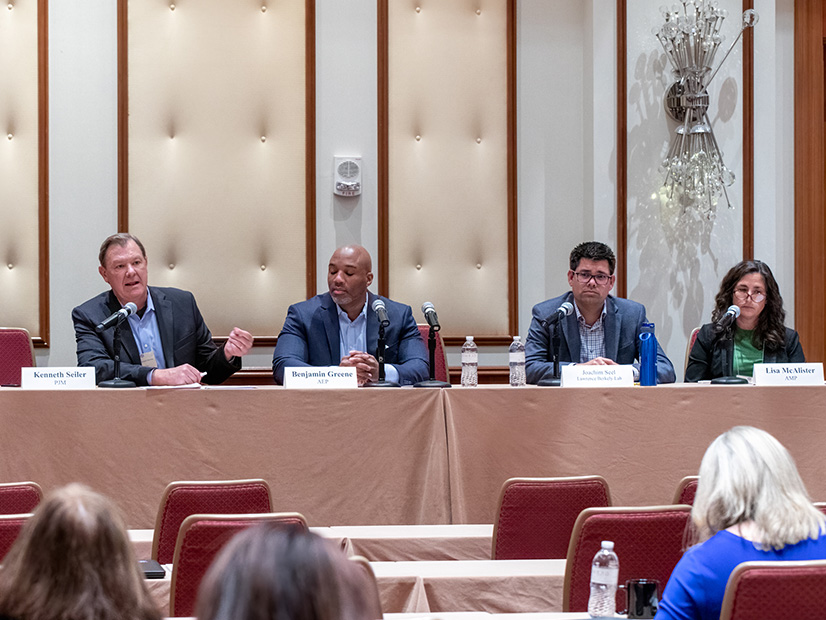
INDIANAPOLIS — Several renewable energy developers and investors filed comments with FERC on Thursday arguing that PJM’s response to the commission’s deficiency letter on its interconnection queue restructuring proposal is insufficient (ER22-2110).
Jointly filing as the Affected Interconnection Customers, the companies argued that PJM has not explained whether the threshold of $5 million of network upgrades under which a project would be eligible to be placed into a fast-track interconnection study queue includes the costs of upgrades that have already been in construction or whose construction could have been fully securitized already through a signed interconnection service agreement (ISA).
Such projects should be permitted to be entered into the fast-tracked expedited process, the companies argued, even if the necessary upgrades would exceed $5 million.
“Network upgrades that have already been constructed or fully securitized prior to the transition date cannot adversely affect subsequently queued projects because they have already been fully committed to financially,” they said. “Transition Cycle projects in queue windows AE1 through AG1 with allocations towards network upgrades that have been fully constructed or securitized (‘fully funded [network upgrades]’) prior to the transition date through a signed ISA should be eligible for the Expedited Process category, regardless of whether those network upgrade allocations are greater than $5 million.”
Without that being the case, the ad hoc group argued that there could be impacts for companies both within the transition queues and those in the pre-transition cycles, which could see their network upgrade burden increase.
“In some instances, it could inadvertently cause such pre-Transition Cycle projects from signing an ISA even though they have remained in queue for up to six years, having planned for network upgrade socialization that PJM is now removing. Such an outcome would be illogical and would not be just and reasonable.”
The group also argued that PJM has not satisfied FERC’s request for justification for the proposed removal of two tariff sections related to reporting and penalties for completing a percentage of the transmission service request studies within a certain time frame. Without further information from PJM, it encouraged FERC to require that the language remain in the tariff until another approach can be found.
“PJM claims to be concerned about inconsistent requirements in its tariff, but PJM does not explain why it cannot consolidate the inconsistent provisions in one place or revise them to fit them into the new regime,” the group said. “PJM also does not try to explain why penalties are no longer needed to enable it to process study requests in a timely fashion, which is very important given the huge backlog of its interconnection queue.”
The group of companies includes Acciona Energy USA, ConnectGen, Copenhagen Infrastructure, Hecate Energy, Leeward Renewable Energy Development, Scout Clean Energy and Tri Global Energy.
Queue Backlog Discussed During OPSI Annual Meeting
During a panel during the Organization of PJM States Inc.’s Annual Meeting discussing the interconnection queue backlog on Oct. 18, American Municipal Power General Counsel Lisa McAlister said she believes that imposing penalties for failing to complete a percentage of the studies could be unfair to both transmission owners and RTO stakeholders.
“While that makes sense and it could be a compliment to the stricter requirements of commercial readiness on the generator’s part, the transmission owners do a lot of the interconnection studies from what I’ve seen, and if they have incomplete information or the information … it doesn’t seem really fair to impose penalties on the transmission owners and then … penalties on the RTO itself,” McAlister said. “The RTO is a nonprofit organization that doesn’t really have independent funds, so those are going to get passed through to PJM members who don’t have any skin in the game and certainly aren’t responsible for not having done the studies.”
Fellow panelist Benjamin Greene, RTO policy manager for American Electric Power, said the penalties could erode the relationship between PJM and its TOs, as well as potentially put the transmission providers in an awkward position of trying to determine which of the two is at fault for studies not being complete.
PJM Vice President of Planning Kenneth Seiler told the panel the RTO is hoping that if FERC approves its proposal soon, it could get through the transition queues within two to three years. Smaller projects that have minimal impact on the grid could be done within six months, with much of the work PJM staff have to commit to studies laying in those projects that would require hundreds of million in transmission upgrades.
Seiler also said he’s hopeful that FERC will revise its interconnection queue Notice of Proposed Rulemaking (RM22-14), issued in June, to remove a proposal to allow developers to ask RTOs and transmission providers to determine the costs of different combinations of projects. Such a rule would increase complexity and slow down PJM’s ability to complete studies, he said. (See FERC Proposes Interconnection Process Overhaul.)
“If we’re going to continue to have optional studies, we’re almost going to go back to where we were or where we are now, which is going to be pretty time consuming. We’re going to have to spin off another group to do optional studies, which everyone else is then taking their studies and deciding if they want to move forward, because all these projects intersect with each other. So the more flexibility we introduce for the developers, the more time it’s going to take for us to process the queues,” Seiler said.

